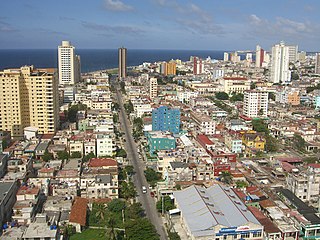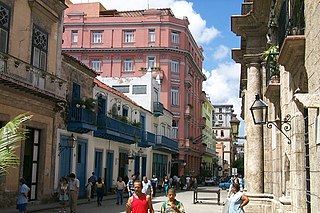Related Research Articles

Havana is the capital and largest city of Cuba. The heart of the La Habana Province, Havana is the country's main port and commercial center. It is the most populous city, the largest by area, and the second largest metropolitan area in the Caribbean region. The population in 2002 was 2,137,847 inhabitants, and its area is 728.26 km2 (281.18 sq mi) for the capital city side and 8,475.57 km2 for the metropolitan zone.

Daína Chaviano is a Cuban-American writer of French and Asturian descent. She has lived in the United States since 1991.

Boyeros is one of the 15 municipalities or boroughs in the city of Havana, Cuba. The municipality was created in 1976, and amalgamated the town of Santiago de Las Vegas. It lies on the south-west side of the city and includes José Martí International Airport.
Fernando Ramón Martínez Heredia was a prominent Cuban revolutionary thinker and politician. Martínez was a founding member of the Cuban Communist Party, and as a member of the July 26 Movement, he took part in the Revolution which overthrow the Batista dictatorship.

Roberto Fabelo, , is a Cuban painter, sculptor, and illustrator.
Carlos Alzugaray Treto is a Cuban diplomat and educator.

Manuel Rodulfo Tardo was a Cuban artist.
Claudio Véliz is an economic historian, sociologist and author from Chile, who has held numerous academic posts in various institutions of higher learning including La Trobe University (Australia), Harvard and Boston University.

The Cuban Institute of Radio and Television was the government agency responsible for the control of radio and television broadcasters in Cuba. On August 24, 2021, the institute ceased to operate and was replaced by the Institute of Information and Social Communication.
Ernesto Dihigo y López Trigo was a prominent Cuban jurist, diplomat, and professor. He served as the Cuban Foreign Minister during the administration of the presidency of Carlos Prio Socarras (1950-1951). He served as the Cuban Ambassador to the United States from January 1959 until February 1961 after the regime of Fulgencio Batista was overthrown by Fidel Castro.

José Antonio Saco was a statesman, deputy to the Spanish Cortes, writer, social critic, publicist, essayist, anthropologist, historian, and one of the most notable Cuban figures from the nineteenth century.
The following is a timeline of the history of Havana, Cuba.
The Archivo Nacional de la República de Cuba is the national archive of Cuba. Founded in 1840, it is located in Havana on Calle Compostela. Directors have included Vidal Morales Morales and Joaquín Llaverías Martínez.
Alberto Arredondo Gutiérrez was a Cuban journalist and economist.
The following is a timeline of the history of the city of Camagüey, Cuba.

The Obispo Street is one of the most famous and traveled streets of Old Havana. During its history, the street has received several names such as: San Juan, Bishop (Obispo), Weyler, Pi Margall, among others, for a total of 47. It is the longest Street in Old Havana. Street shops have always been abundant alongside O'Reilly Street, which is parallel to it from its inception from Zulueta to Havana Bay.
Abel Sierra Madero is a Cuban author and scholar who was awarded the Casa de las Américas Prize in 2006.

Salvador José de Muro y Salazar, 2nd Marquis of Someruelos, in Spanish: Marqués de Someruelos,, was a Spanish military officer who served as a lieutenant general of infantry and a field marshal in the Spanish Army, as captain general of Cuba and governor of Havana, and as president of the Real Audiencia of Puerto Príncipe.
Alfredo Diez Nieto was a Cuban composer, conductor, and professor. He taught composition at Instituto Musical Kohly, the Amadeo Roldán Conservatory, the National Art School, and the Instituto Superior de Arte in Havana. He founded and conducted the Orquesta Popular de Conciertos. Diez Nieto composed orchestral works including three symphonies and chamber music for various instruments, using and transforming elements from Cuban folk music.
References
- ↑ "Quiénes somos" (in Spanish). Havana: Instituto de Historia de Cuba. Retrieved October 7, 2016.
- ↑ Oliveira 2016.
- ↑ "Áreas y Líneas de Investigación del IHC" (in Spanish). Havana: Instituto de Historia de Cuba. Retrieved October 7, 2016.
This article incorporates information from the Spanish Wikipedia.